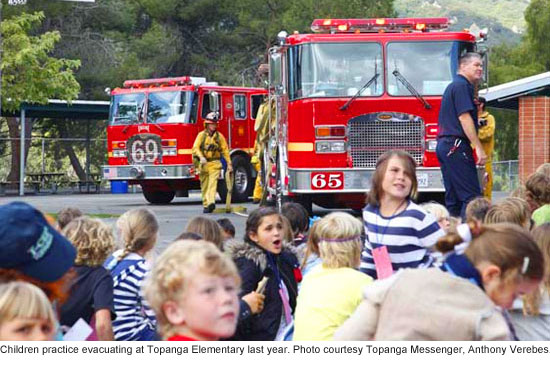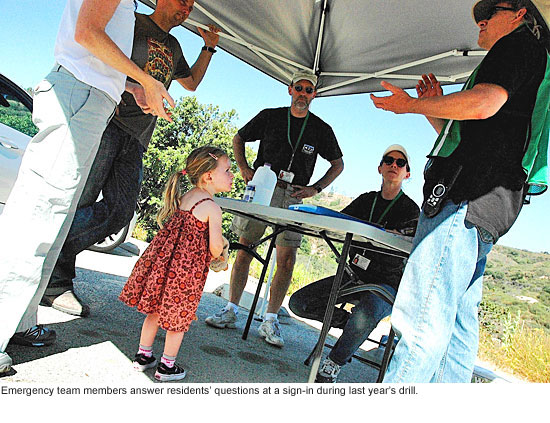Practicing for peril in paradise
April 28, 2011
 Topanga Canyon is one of the most storied and bucolic nooks in Los Angeles County. It is also one of the most fire-prone.
Topanga Canyon is one of the most storied and bucolic nooks in Los Angeles County. It is also one of the most fire-prone.
The only way in or out is via a winding and often-gridlocked blacktop. Gardens and yards intertwine with flammable chaparral and tinder-dry wildlands. Past fires have shown over the years that the canyon could burn end to end in less than half the time it would take for its 12,000 inhabitants to get to safety.
“There’s a reason we call Topanga the ‘Perilous Paradise’,” says Maria Grycan, community services liaison for the Los Angeles County Fire Department.
“It’s one of the most beautiful places to live and play, but with that beauty comes a great deal of danger in terms of wildfires.”
This is why Topanga has adopted one of the more aggressive strategies in Los Angeles County when it comes to drilling for fire safety: On May 7, for the second year in a row, residents will practice evacuating the entire town.
Sometime in the morning, Topangans will be roused by the sort of “emergency” phone call they could expect in the event of a fast-moving brushfire. If they’ve done their homework, they’ll know what to do next; if not, they’ll have plenty of firefighters around to help them.
Either way, within a few minutes, if all goes as planned, thousands of canyon dwellers will show up and sign in at an assortment of designated addresses where they could survive a wildfire if the canyon’s escape routes were blocked or congested.
Think of it as a massive dry run for an ongoing threat, but don’t call it a fire drill, says Grycan.
“Drills are just to get people out of a burning building,” she says. “This is way beyond that. We’re dealing with a whole canyon here.”
The exercise, which drew nearly 1,100 participants last year, is considered a crucial link in Topanga’s emergency planning. With the serpentine Topanga Canyon Boulevard as the only main road in or out, Topanga is vulnerable to bumper-to-bumper traffic even on better days. Authorities have estimated that evacuating the whole community could take close to six hours—enough time for the town to burn more than twice over, says Grycan. “A fire that started on the north end of Topanga could get all the way through town and to the coast in less than two and a half hours.”
Also, despite its rural reputation, some parts of Topanga are densely populated.
“We live in the Fernwood area, which has so many trees and so many houses that if a fire came to Fernwood, it would be like Armageddon,” says Debra Silbar, who took part in last year’s drill with her then-14- and 9-year-old children in tow.
So at the county’s behest, the unincorporated community has sought in recent years to become a model for preparedness, splitting itself into nine “tactical zones” for easier evacuation, publishing a “Topanga Disaster Survival Guide”, designating safe – or at least survivable – meeting points throughout town for times when evacuation won’t work and educating residents with an annual Topanga Safety Week and evacuation exercise.
This year’s Safety Week will begin May 2 with a series of daily activities to promote awareness. Grycan says a workbook will be mailed to every household to help locals freshen their knowledge. Topanga Elementary School will drill on Wednesday, and county firefighters will demonstrate firefighting techniques.
The week will culminate with the community-wide evacuation exercise from 9 a.m. to 11 a.m. on Saturday, May 7. Led by the county fire department, the drill will involve an array of local law enforcement, first responders and government and community volunteer organizations, says Grycan. “The premise is, there’s a fire, the road is in gridlock, evacuation is not an option. Where do you go?”
The exercise, she says, will help residents remember the answers to that question.
“Our first preference in the event of a fire is that people leave early enough that they can get out of the canyon,” says Grycan. “Plan B is, if you can’t get out, then get to a safety area. And Plan C is, if you can’t do Plan B, then at least get to a neighborhood survival area where, say, a fire is more likely to blow over you, or where, if you were caught in a fire, you’d be more likely to survive.”
Additionally, she says, the drill will allow local emergency workers to practice their internal coordination, and will offer a chance to test Alert LA, the mass notification system that they were unable to use last year. Grycan says a last-minute glitch forced emergency workers to use a fallback notification system that only allowed notification of residents with landlines. As a result, many Topangans failed to get the reminder, particularly in less densely populated areas of the canyon.
“We were one of the evacuation sites but nobody showed up at our place,” says Patricia Moore, whose 6-acre Eden Ranch has been designated a neighborhood survival area because of its flat terrain and ample access to water. “There were two people here to take names, and they just kind of sat there, which was kind of sad.”
Pat MacNeil, former chair of the volunteer Topanga Coalition for Emergency Preparedness, says she expects turnout to be even better this year.
“With all the disasters in Chile and Japan and Louisiana, people are becoming more aware of the fact that they have to take care of themselves,” she says.
Meanwhile, locals like Silbar say they are looking forward to reprising their civic duty.
“Last year, I put my kids in the car, we drove down and checked in and it literally took one minute,” she says. “It was a simple way to help out the community. But we’ve also had to evacuate before, and we know how crazy things can get in those situations. Drills like this, I think, help our kids realize what happens when there’s an emergency in the canyon, and will give them a better sense of control.”
Posted 4/28/11













 405 bridge work causes a stink
405 bridge work causes a stink
